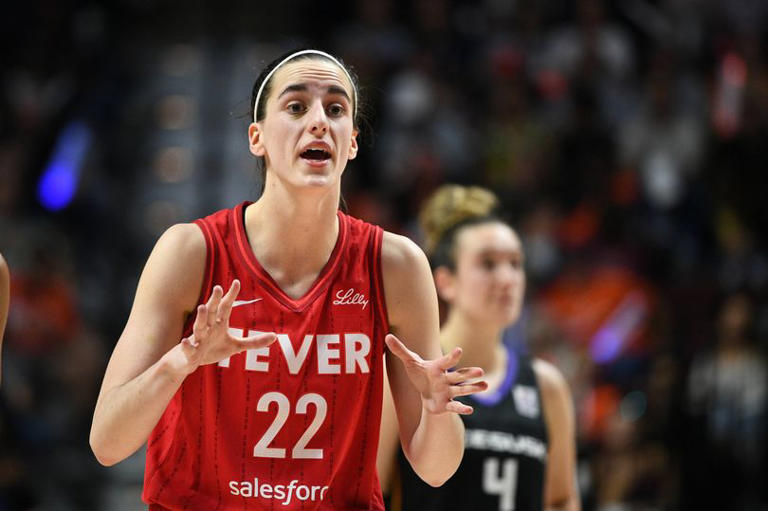A basketball legend asserts that WNBA competitors “hate” Caitlin Clark.
The assertion that WNBA competitors “hate” Caitlin Clark is a claim that carries significant implications in the world of basketball. Caitlin Clark, one of the brightest stars in NCAA women’s basketball, has garnered attention for her spectacular performances on the court, her fearless personality, and her ability to dominate opponents. Yet, despite her rising prominence, the assertion that WNBA players “hate” her is a complex and contentious one, which must be examined within the context of competition, rivalries, media narratives, and gender dynamics in basketball.
In order to understand why such a claim might arise, it’s important to consider the multiple layers that could contribute to it, including the nature of competition in professional and collegiate sports, how women’s basketball is often viewed in relation to men’s basketball, and the pressures faced by female athletes in a world dominated by male counterparts.
Caitlin Clark’s Rise in Basketball
Caitlin Clark’s rise to stardom in NCAA women’s basketball has been nothing short of remarkable. Playing for the University of Iowa, Clark quickly became a household name due to her ability to score from virtually anywhere on the court. Her combination of ball-handling, shooting range, and basketball IQ made her one of the most captivating players in the sport. She has often been compared to male players in terms of her style of play, and some have even gone as far as to call her the best shooter in the game, regardless of gender.
Clark’s ability to hit deep three-pointers, break down defenses, and produce highlight-reel performances quickly earned her a following among fans of both women’s and men’s basketball. In addition to her offensive prowess, Clark also became known for her confident, fiery demeanor—traits that have made her a polarizing figure.
However, her rapid ascent to stardom did not come without controversy. As her popularity grew, Clark attracted criticism from some opposing players, coaches, and analysts who questioned whether her style of play—particularly her confidence and occasional showboating—was seen as disrespectful. Her trash talk, bold celebrations, and outward expressions of confidence did not sit well with everyone, leading to divided opinions about her behavior.
The Role of Rivalries in Women’s Basketball
In basketball, rivalries are a natural part of the sport. Teams, coaches, and players often find themselves at odds with one another, especially when they share similar aspirations for championships, accolades, and recognition. Rivalries tend to fuel intense competition, and in women’s basketball, such rivalries can sometimes become more personal due to the close-knit nature of the sport.
Given Clark’s prominence on the collegiate level, it is understandable that some may see her as a threat or as someone who could challenge the established order in women’s basketball. For example, players from other powerhouse programs like Stanford, South Carolina, or UConn may view Clark’s success as a sign that Iowa could become the new face of women’s college basketball. As such, the pressure to compete against her would be heightened, leading to a greater sense of rivalry between players.
Moreover, players in the WNBA—the highest level of professional women’s basketball—may view Clark’s rise through a different lens. The WNBA is a league that has long fought for respect and recognition within the larger sports landscape, often facing criticism for its lower pay, fewer endorsements, and less media coverage compared to the NBA. For WNBA players, seeing a young player like Clark garner so much attention could be seen as both exciting and frustrating. The notion that she could soon be the face of women’s basketball—without yet stepping foot in the WNBA—might create a sense of competition for the spotlight that has long been dominated by the players who have spent years honing their skills in the professional league.
Gender Dynamics and Media Narratives
Gender dynamics play a significant role in shaping perceptions of athletes, particularly in women’s sports. Historically, female athletes have had to fight for visibility and legitimacy in ways that their male counterparts have not. For example, female basketball players have often been overlooked in favor of their male counterparts, leading to the underrepresentation of women in sports media and a general lack of recognition for their achievements.
As Caitlin Clark’s success has brought more attention to women’s college basketball, there may be an underlying tension between her rise and the struggles of women’s professional basketball. The WNBA, while a respected league, often faces criticism for its perceived lack of mainstream popularity. While men’s basketball receives global attention and endorsement deals, the women’s game has not received the same level of financial investment and media exposure. Clark, as a young player, may be seen by some as a symbol of the growing potential for women’s basketball, while others may feel that her success detracts from the efforts and struggles of those who have already been part of the WNBA.
Additionally, the media plays a critical role in shaping how athletes are perceived, particularly when it comes to the narrative surrounding women’s sports. The portrayal of female athletes can often emphasize their physical appearance, emotional expressions, or controversial actions—tactics that may detract from their athletic achievements. In Clark’s case, her confidence and aggressive play may be framed in ways that draw attention to her “personality” rather than her skill set, a narrative often used to cast female athletes in a more divisive light.
The media’s tendency to sensationalize personal stories and rivalries could contribute to the idea that Clark has “enemies” or that WNBA players “hate” her. Rivalries in sports often sell, and the concept of animosity or conflict between athletes can be an alluring narrative for fans and media alike. However, this narrative is often more a product of media creation than a reflection of reality.
The Misinterpretation of Competitiveness as Hatred
One of the central issues in understanding the claim that WNBA players “hate” Caitlin Clark is the tendency to misinterpret competitiveness as personal animosity. In professional sports, particularly in basketball, intense rivalries are commonplace. However, rivalry does not equate to hatred. Athletes are often driven by competition and the desire to prove themselves as the best, which may lead to heated moments on the court or critical statements off the court. These emotions, however, are generally tied to the sport and the nature of competition rather than personal hatred.
In fact, many WNBA players have expressed admiration for Clark’s skill and playing style. Players like Sabrina Ionescu and others have publicly praised Clark for her game and have acknowledged her as one of the most exciting players in basketball today. Instead of animosity, there is more likely a sense of mutual respect among professional players, even if they feel the pressure of competing against her.
Additionally, the notion of “hatred” may be a product of expectations placed on female athletes to be more demure or less aggressive than their male counterparts. In men’s basketball, a player’s confidence, trash talk, and intense rivalries are often seen as part of the game’s competitiveness. For women, these same traits can be framed as contentious or “hateful.” This creates a double standard in which female athletes are expected to be less assertive, and when they break from that mold, their actions are scrutinized in a way that male athletes’ behavior would not be.
The assertion that WNBA players “hate” Caitlin Clark likely stems from the competitive nature of sports, media narratives, and the challenges faced by women’s basketball in an ecosystem that prioritizes men’s sports. While rivalries and fierce competition are natural components of any sport, especially at the elite level, it’s crucial to understand that the idea of “hate” is often an oversimplification of the complex dynamics between players, teams, and media.
Caitlin Clark is undoubtedly a major force in women’s basketball, but her rise is part of a larger conversation about the visibility, respect, and recognition of female athletes in a sports landscape that has historically sidelined them. Rather than focusing on divisive narratives, it is more productive to appreciate the fact that her success reflects the growing potential and recognition of women’s sports. The WNBA, as a professional league, continues to evolve, and Clark’s success may help to draw more attention to the league in the years to come. At the end of the day, sports are about competition, respect, and a shared love for the game—something that transcends any notion of hatred.



